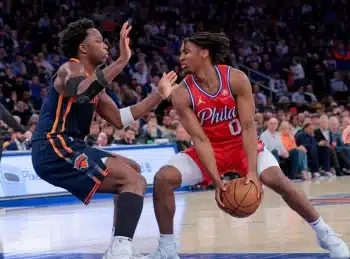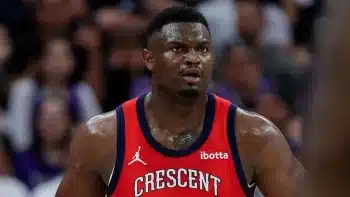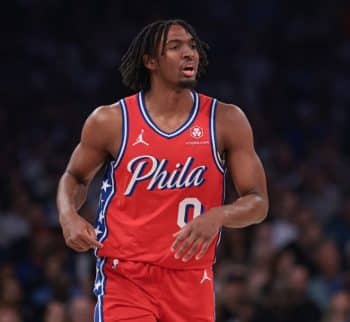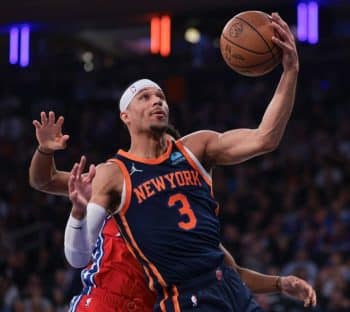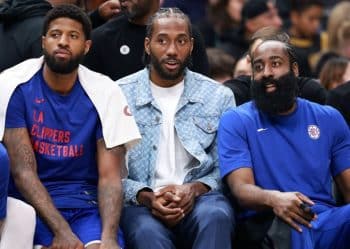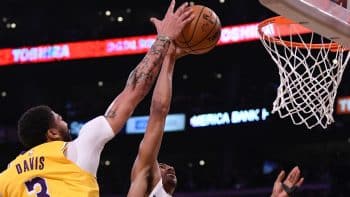NBA
Cheap Seats: Defensive Player of the Year?

Every season, we welcome in a new group of interns and typically their work is done primarily behind the scenes. But now that the current group has been around for awhile, we’re giving them a platform to voice their thoughts on the NBA. Each week, Basketball Insiders’ interns Jesse Blancarte, Cody Taylor and John Zitzler will discuss a topic related to the league in Cheap Seats.
This week, the interns discuss the race for the 2013-14 Defensive Player of the Year award.
Roy Hibbert
Last year, Roy Hibbert finished 10th in Defensive Player of the Year voting and was not voted onto any of the All-Defensive teams. Hibbert was upset and said he was overlooked by media members who didn’t watch Indiana Pacers games. Fans and media members have been paying attention to Indiana throughout this season and have taken notice of Hibbert’s impact on the defensive end.
Last year, Hibbert averaged 11.9 points, 8.3 rebounds and 2.6 blocks per game. This year, Hibbert is averaging 11.2 points, 6.9 rebounds and 2.3 blocks. So how could a center who finished 10th last year suddenly be in the discussion for Defensive Player of the Year while getting less rebounds and blocked shots per game? Gauging the defensive impact of a player based on traditional statistics alone has always been an imperfect measure.
However, this year the NBA started using SportVU cameras in each arena, which offer new insights into player productivity. NBA.com explains that the camera system “tracks the movements of every player on the court and the basketball 25 times per second. The data collected provides a plethora of innovative statistics based around speed, distance, player separation and ball possession.”
This new data shows that Hibbert is elite at anchoring the Pacers’ league-leading defense. Opponents attempt 10.3 shots at the rim per game with Hibbert defending. This is a high number of attempts, up there with players like DeAndre Jordan of the Los Angeles Clippers, who defends against 10.4 shots at the rim per game. But Hibbert allows opponents to shoot only 41.1 percent at the rim, whereas Jordan allows opponents to shoot 49.4 percent. Hibbert even matches up favorably to Joakim Noah, who allows opponents to shoot 45.7 percent at the rim on 7.5 attempts per game.
Defending the rim is not the only thing that should be considered in terms of defensive contributions, but it is very important. Teams like the Houston Rockets are emphasizing high efficiency shots, which includes three-pointers and shots at the rim. In fact. 52.27 percent of Houston’s overall field goal attempts have been at the rim this season. The Rockets may be an extreme example, but other top teams take a large percentage of shots at the rim as well, such as the San Antonio Spurs (43.64 percent) and Miami HEAT (42.68 percent). This means Hibbert is taking away the highest efficiency shot from some of the league’s best offenses, which is very significant.
In addition, wing defenders like Paul George, Lance Stephenson and George Hill can play aggressive defense on the perimeter knowing that Hibbert is near the basket as backup. When opposing players manage to get past these defenders, Hibbert is often waiting on the backline to alter any shots within in his range. At 7’2, Hibbert is able to cover a lot of ground and affect opposing players as they attack the rim. When the attacking player is someone like LeBron James, the results can be violent.
Hibbert has also improved his footwork and lateral speed, which allows him to show harder on guards probing the paint from the perimeter. He also has improved his timing and awareness of when to rotate from the weak-side to help out on a player driving towards the basket. This improved defense at the rim, coupled with the strong perimeter defense from players like George, has Indiana firmly placed as the top defense in the league as the Pacers allow opponents to score only 96.1 points per 100 possessions.
The second-best defensive team is the Chicago Bulls, allowing 97.7 points per 100 possessions. It is not surprising that the Bulls are in the top-two since Noah anchors the defense in Chicago. His energy and defense at the rim are undeniably solid, and he has improved within Tom Thibodeau’s strong-side defensive system. Noah also posts better traditional stats, averaging 12.4 points, 11.1 rebound, 5.2 assists, 1.2 steals and 1.5 blocks per game. While Noah has certainly upped his play lately, and stabilized the gritty Bulls after a rough start to the season, it would be a mistake to ignore what Hibbert and the Pacers were doing earlier in the season.
From early November until early January, the Pacers were holding teams to 93.7 points per 100 possessions. The second closest team at the time was the Oklahoma City Thunder, who allowed 97.6 points per 100 possessions. While the Pacers have fallen on hard times recently, going 7-11 in their last 18 games, it would be unfair to not remember that people were asking whether Indiana had put together the best defense in Pacers’ history and one of the best defenses in NBA history early in the season. Additionally, it has been Indiana’s offense that has hurt them lately more so than the defense.
Acknowledging Hibbert’s elite defense at the rim, it must also be stated that he needs to improve his rebounding. DeAndre Jordan gets 19.3 rebound chances per game – which is simply each time a player is within 3.5 feet of a rebound – and pulls in 71.6 percent of them, good for a league leading 13.8 rebounds per game. Hibbert gets 13.6 rebound chances per game, but only hauls in 50.5 percent of them, good for 6.9 rebounds per game. At 7’2, Hibbert should be grabbing more rebounds. However, the Pacers still bring in the seventh most rebounds per game as a team, so this area has not hurt the team significantly. Also, some of the top-10 rebounders include players like Kevin Love (12.6), DeMarcus Cousins (11.6), LaMarcus Aldridge (11.1) and Al Jefferson (10.5), none of whom are considered elite defensive anchors. So while rebounding is important and an indicator of a player’s defensive impact, it is not the best measure to rely on. Though it must be noted that other top defensive players are also in the top-10, including Jordan (13.8), Dwight Howard (12.3) and Noah (11.1).
There is tight competition for this year’s Defensive Player of the Year award. However, Hibbert stands apart by protecting against the most efficient shot in the NBA, shots at the rim, better than anyone else. His size alone deters opponents from going straight to the rim, even when he is on the weak-side. His teammates are able to stay close to wing players on the perimeter, and hold opposing teams to just 37.3 percent shooting from 20-24 feet, good for seventh best in the league.
Hibbert will not win Defensive Player of the Year based on a traditional stat sheet. Fortunately for him, fans and members of the media have paid attention to the Pacers this year and his overall impact on their defense. It would be unfair to overlook his defensive impact from earlier this season because of Indiana’s recent struggles. Adding these new cameras only confirms what we see on the court, that Hibbert is a towering presence on defense and his overall effect on opposing teams goes beyond blocks and rebounds. He fundamentally changes the way in which opposing teams play against the Pacers, and it has resulted in the best defense in the league. Hibbert was overlooked last year. Let’s not make the same mistake this year.
– Jesse Blancarte
Paul George
In a category traditionally dominated by big men, it’s easy to overlook guards and small forwards when thinking about the top defensive players. The last time a guard or small forward won the Defensive Player of the Year award was Ron Artest in the 2003-04 season. Before Artest, it was Gary Payton in the 1995-96 season. This season, the award should go back to a small forward in Paul George.
Forget the idea that George is also in the race for Most Valuable Player, he should be considered as a serious contender for Defensive Player of the Year. George is currently fifth in the league in total steals with 143 (or 1.9 per game) and fourth among small forwards in rebounding with 459 (or 6.7 per game). One aspect of George’s game that allows him to pressure ball handlers is his 7’0 wingspan and quick foot work. In three games against LeBron James and the Miami HEAT, James shot 51 percent from the field, down from his 57 percent overall percentage, and his three-point percentage was down seven points from his season average.
Perhaps the biggest stat that helps George’s chances at winning the award is defensive win shares. A defensive win share is defined as a metric that estimates the number of wins a player produces for his team due to his defensive ability. George leads the league in defensive win shares at 6.2, ahead of Joakim Noah, DeAndre Jordan and teammates David West, Roy Hibbert and Lance Stephenson. Currently George’s 6.2 defensive win shares is broken down to .081 per game, a number that would put him in a group among the league’s all-time best for guards and forwards. George’s .081 is higher than Michael Jordan’s win share per game of .0744 when he won the award in 1987-88 and higher than Payton’s .069. The all-time high for defensive win shares per game is .0854 by Scottie Pippen in 1994-95.
As far as defensive rating goes, George is third in the league at 96.6 behind only Noah and Andrew Bogut. The Pacers as a team have four total players in the top 20, which is a nod to Pacers head coach Frank Vogel’s league-leading defensive efficiency. While the Pacers’ defense remains intact, the team’s offense has struggled to find ways to put points on the board, averaging 93 points per game since the All-Star break versus 98 points per game prior to the break. The team has gone 13-12 since the break, but George continues to provide the team with a bright spot on the defensive end, improving his rebounds per game from 6.4 before the break to 7.5 per game since the break.
George’s tear on defense isn’t new; he also led the league last season in defensive win shares with 6.3 or .08 per game. George’s numbers last season were greater than those of Marc Gasol, who won the award. While George’s outstanding year on the defensive side of the ball may go unrecognized again, leading the league in defensive win shares in back-to-back seasons must count for something.
– Cody Taylor
Joakim Noah
The Chicago Bulls’ season has been a grind from the beginning. The team has had every reason pack it in, but somehow seems to be playing their best basketball of the year heading into the postseason. The key to their success is obvious – defense. The team has struggled scoring all season, averaging only 93.3 points per game, but they have managed to make it even more difficult for their opponent to score, giving up just 91.8 points per game. The anchor of this stingy group is, of course, center Joakim Noah. Noah, who has always been considered a very solid player on the defensive end, has really come into his own this year and is now right in the thick of the Defensive Player of the Year conversation.
The Bulls’ success on the defensive side relies heavily on their active center being able to control the paint and contain in pick-and-roll situations. Noah has done and exceptional job at both.
Rebounding has always been a strength for Noah and this season has been no different; he is cleaning the glass to the tune of 11.1 boards a night. Noah, a good athlete but different from a guy like DeAndre Jordan, excels at getting great position under the rim. His constant activity can cause problems and make it very difficult for some of the slower, less nimble big guys to stay in front of Noah and keep him off the backboard. He has one of the best motors in the league and is able to wear down his man by constantly working to rebound the ball.
Roy Hibbert is the standard right now when it comes to defending at the rim with opponents only scoring on 41 percent of their attempts against him this season. Noah, however, isn’t far behind. Opponents are only scoring on 46 percent of their attempts at the rim when he is down low patrolling the paint. Noah is not an elite shot blocker, but is able to deter shots around the rim by using his quick feet to stay in front of his man and by being active with his hands. He is adept at drawing charges and will almost certainly make opposing players pay if they go to the rim out of control. Also, Noah’s quickness is a great asset when it comes to help defense, as it allows him to effortlessly rotate and cover when his team is scrambling and caught out of position.
While he is a very good interior defender and rebounder, the most impressive aspect of Noah’s defensive performance this year may be his work in pick-and roll-situations. Again, his quickness really benefits him when attempting to contain an attacking guard. His ability to move in space at his size is what really separates Noah from other centers in the NBA. He has great feet, and it’s always entertaining to see Noah get switched up on a guard. The guard thinks they have a big advantage in quickness and can blow right past Noah, but more times than not Noah is able to contain penetration and force a tough shot. The stats just illustrate this point even more. In pick-and-roll situations with Noah defending, opponents are shooting only 34 percent from the field. It’s even more impressive when you compare Noah’s work in pick-and-roll situations with other top big men. Opponents in pick-and-roll situations with Dwight Howard defending are shooting 41 percent from the field and even worse for DeAndre Jordan, allowing opposing players to shoot 47 percent from the field. Noah’s lateral quickness pays huge dividends in these situations and it allows him to aggressively hedge on screens and suffocate the ball handler knowing he has the foot speed to recover back to his man in time. His versatility makes him so unique and will be very valuable in the playoffs as it may create a number of matchup issues.
Noah has been fantastic all season long defensively. His consistent minutes and steady play have been integral in the Bulls’ late season surge. When you couple the fact that the Bulls are at the top or near the top of the league in almost every team defensive category with Noah’s strong individual numbers defensively, it would blasphemous if he wasn’t given serious consideration in the Defensive Player of the Year race. He has been the glue to the toughest unit in the league and that shouldn’t be overlooked. Of course, credit must be given to head coach Tom Thibodeau as he is the mastermind behind the defense, but without Noah it’s hard to imagine this Bulls unit being as nearly as stingy as it has been.
– John Zitzler
